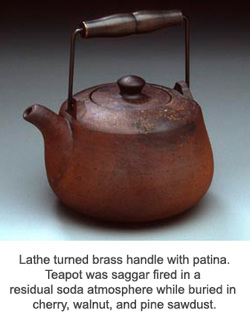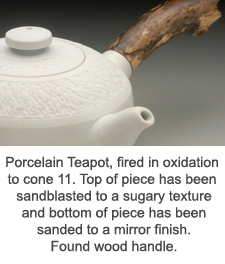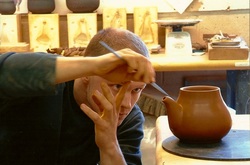Teapot Technicals

I spent a few months developing the clay bodies I would use for this project. For both functional and aesthetic reasons I wanted to stay close to the traditions of Yixing’s unglazed wares. Because I wasn’t going to be glazing these pieces, my color pallet was dictated solely by the clays I created. From a color standpoint, I was looking for bodies that would produce multiple hues and react in different ways to various firing processes. From a functional standpoint, I needed the clays to be vitreous enough to be food safe, yet porous enough to absorb the oils of the teas. A Yixing story tells of a teapot that was used so often, and had absorbed so much oil, that a pot of tea could be brewed by just adding hot water to the teapot.
The actual design of the teapot is extremely important and intrinsically tied to the quality of its functionality. Spout placement, handle proportion, lid tightness, the angle of the tip of the spout, spout dimensions; these are only a few examples of the decisions considered in the building process. One of the results of the careful attention to detail can be demonstrated by a principle known as the quiet rule. When pouring from a teapot, the sound of the liquid pouring into a cup should not be heard until the tip of the spout is raised at least ten centimeters above the surface of the liquid already in the cup.
The actual design of the teapot is extremely important and intrinsically tied to the quality of its functionality. Spout placement, handle proportion, lid tightness, the angle of the tip of the spout, spout dimensions; these are only a few examples of the decisions considered in the building process. One of the results of the careful attention to detail can be demonstrated by a principle known as the quiet rule. When pouring from a teapot, the sound of the liquid pouring into a cup should not be heard until the tip of the spout is raised at least ten centimeters above the surface of the liquid already in the cup.

Another test of details is to see if the lid is air-tight. Almost all teapots will have a hole in the lid to balance the displacement of water when liquid is being poured. Air needs to be able to flow into the teapot in order for there to be a smooth flow of liquid out of the teapot. In the majority of pieces in this series, the teapot can be filled and if the hole in the lid is plugged, no liquid will pour from the spout.
Surface treatment is a very important part of my work. The majority of these pieces are sanded and sandblasted after being fired. I consider the users tactile response to these pieces to be as important as the visual and functional aspects. The three porcelain teapots are great examples of this. The bottom half of these pieces have been sanded by hand to a mirror finish. I started with a sixty grit sand paper and worked my way up to a three thousand grit paper, usually used in fine automotive finishing. The tops have been sandblasted, leaving a porous sugar-like texture. This will absorb oils from the teas as well as oils from people’s hands as the teapot is used.
Surface treatment is a very important part of my work. The majority of these pieces are sanded and sandblasted after being fired. I consider the users tactile response to these pieces to be as important as the visual and functional aspects. The three porcelain teapots are great examples of this. The bottom half of these pieces have been sanded by hand to a mirror finish. I started with a sixty grit sand paper and worked my way up to a three thousand grit paper, usually used in fine automotive finishing. The tops have been sandblasted, leaving a porous sugar-like texture. This will absorb oils from the teas as well as oils from people’s hands as the teapot is used.

The handles for these pieces were made from dead bramble bushes I had collected. After drying the wood for about two months, I went through twenty yards of material to find the three pieces I used. They needed to match the angle of the body of the teapot exactly, as well as balance the piece both physically and visually, and feel good in the hand. The wood, along with other materials chosen for handles, sandblasted metal, woven cane, leather, turned brass, will all absorb oils as they are used. The idea that the teapots will visually age with use is an important concept in this series. If you have any questions about the information or concepts described above, please feel free to contact me.
Nate Sonnenberg
Nate Sonnenberg